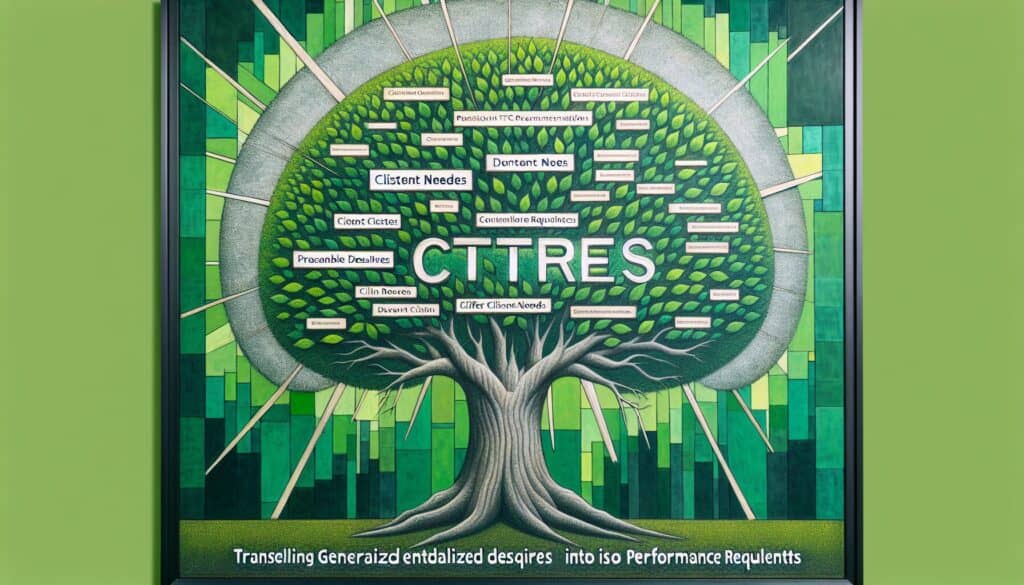To translate broad customer needs into specific, measurable performance requirements.
- Méthodologies : Ingénierie, Ergonomie
Critical to Quality (CTQ) Tree

Critical to Quality (CTQ) Tree
- Critical to Quality (CTQ), Expérience client, Cartographie de l'itinéraire du client, Amélioration des processus, Optimisation des processus, Assurance qualité, Contrôle de qualité, Déploiement de la fonction qualité (QFD), Gestion de la qualité
Objectif :
Comment il est utilisé :
- Starts with a critical customer need, then branches out to identify key drivers and finally specific, measurable characteristics that must be met.
Avantages
- Provides a clear line of sight from customer needs to process requirements; helps prioritize efforts.
Inconvénients
- Can be time-consuming to develop comprehensively; may require significant customer input to be accurate.
Catégories :
- Lean Sigma, Conception de Produits, Qualité
Idéal pour :
- Defining and prioritizing key quality characteristics based on customer needs.
The CTQ Tree methodology is particularly beneficial in industries where meeting customer expectations is paramount, such as automotive, healthcare, and consumer electronics. This methodology can be employed during the requirements gathering phase of product development, enabling teams to translate customer demands into actionable specifications. Stakeholders, including product managers, engineers, and quality assurance teams, should be involved in the process to ensure a comprehensive understanding of customer needs and to facilitate collaborative identification of key drivers and measurable characteristics. For instance, in the automotive sector, a CTQ Tree may help elucidate customer preferences for safety features by breaking down the overarching need for safety into specific criteria like airbag deployment speed or the effectiveness of braking systems, which can then be measured and tested throughout the design and manufacturing process. This structured approach not only prioritizes aspects that most significantly impact customer satisfaction but also aligns cross-functional teams towards common quality objectives. By establishing a clear connection between customer feedback and tangible product attributes, the methodology promotes accountability and encourages a culture of quality within organizations, ultimately leading to improved product offerings and a stronger market position.
Principales étapes de cette méthodologie
- Identify the primary customer need.
- Map the primary need to potential key drivers.
- Determine measurable characteristics linked to each driver.
- Prioritize the characteristics based on their impact on customer satisfaction.
- Define specifications for each prioritized characteristic.
Conseils de pro
- Involve cross-functional teams early in the process to ensure diverse perspectives on customer needs and drivers.
- Utilize statistical methods such as Design of Experiments (DOE) to quantify the relationship between CTQs and their impact on customer satisfaction.
- Regularly revisit and revise the CTQ tree as customer feedback and market conditions evolve, ensuring alignment with real-world needs.
Lire et comparer plusieurs méthodologies, nous recommandons le
> Référentiel méthodologique étendu <
ainsi que plus de 400 autres méthodologies.
Vos commentaires sur cette méthodologie ou des informations supplémentaires sont les bienvenus sur le site web de la Commission européenne. section des commentaires ci-dessous ↓ , ainsi que toute idée ou lien en rapport avec l'ingénierie.
Contexte historique
1962
1970
1972
1980
1980
1986
1986
1960
1963
1970
1980
1980
1980
1986
1987
(si la date est inconnue ou n'est pas pertinente, par exemple "mécanique des fluides", une estimation arrondie de son émergence notable est fournie)















Articles Similaires
Questionnaires sur les troubles musculo-squelettiques
Tests à plusieurs variables (MVT)
Analyse de régression multiple
Systèmes de capture de mouvement
Méthode MoSCoW
Test de la médiane de Mood